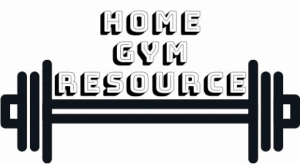If you’re like me, you’ll have looked at a few spaces in your house and wondered if a home gym will fit in there. Well, it depends on what your goals are and how much space you have. Since I don’t know how much space you have, I figured out how much space you need for the most popular home gym setups.
For a basic weightlifting setup with bench and dumbbells you need at least 84″ by 96″ (56 sq. ft.) of free space. If you want to add a power rack and barbells this grows to 101″ by 96″ (67.3 sq. ft.). Those dimensions are large enough to fit the equipment and use it, including bodyweight exercises.
| Setup | Width (inch) | Length (inch) | Total (sq. ft.) |
|---|---|---|---|
| Power rack +Barbell + Bench | 89 | 96 | 59.3 |
| Dumbbells + Bench | 84 | 96 | 55.9 |
| DB +BB+ Rack + Bench | 101 | 96 | 67.3 |
| Multi station gym (small) | 72 | 60 | 29.9 |
| Multi station gym (large) | 72 | 108 | 53.9 |
| Treadmill | 35 | 75 | 18.2 |
| Elliptical | 68.1 | 28.5 | 13.5 |
| Rowing machine | 48 | 96 | 31.9 |
| Exercise bike | 36 | 57.6 | 19.2 |
| Bodyweight exercises | 48 | 96 | 31.9 |
Contents
How Much Space Do You Need For a Weightlifting Home Gym?
Let’s first look at my preferred use of a home gym; weightlifting. Which equipment do you need and how much space do you need to place that equipment and also properly use it.
Equipment in a weightlifting home gym
There are many different types of weightlifting equipment. And therefore there are a million different combinations of equipment you could get for your home gym. However, not all combinations are good because the combination doesn’t allow you to train your whole body.
There are a few proven combinations that work very well and that provide you the opportunity to train the whole body. Those are combinations of free weights and supporting equipment. Free weights are pieces of equipment that are not set in a single path but can move freely. E.g. dumbbells, barbells, kettlebells.
Here are the three best free weight setups and how much space you need for them.
Example #1: Free weights setup with barbell and rack
The classic weightlifting setup is this;
- Barbell
- Weight plates
- Power rack/squat stands
- Bench
It’s a compact setup that’s been used by countless athletes, bodybuilders and home gym enthusiasts. A barbell with the rack and bench is very flexible. You can do a lot of exercises with these pieces. Enough exercises to work out your whole body and get strong.
This is the setup for people with a very limited amount of space but want to build a lot of muscle.
The size we need for this setup is mostly decided by the dimensions of the equipment.
If you want to see which equipment I recommend for home gyms, click here.
Width
The widest thing in this setup is the Barbell: 84” or 79” long. If you’re restricted in space, go for the shorter one. To use the barbell (move it up and down, put on plates), you need some extra space on both sides of the bar. At least 5” but preferably 10” on both sides is good. That means you need a space of 89” (226 cm) to 104”(264 cm) wide depending on the barbell. It’s possible to use a 6’/72” barbell in some cases but both the bar and rack have to be matched otherwise the bar could be too narrow to fit on the rack.
Since the barbell is the widest thing in this setup, this is the width we need for a home gym. Other equipment like the rack and bench are narrower than the length of the barbell. That leads to the length you need;
Length
In the other direction, the longest thing is going to be the bench. An adjustable bench is about 4.5’-5’ long depending on the model. You need a bit more length to actually use it though. The exercise that requires the most length is going to be the bench press. Your legs will stick out when lying on the bench while on the other side, you don’t push the bench up against the wall. On the one side you want about a 1’ distance from the wall while your legs need another 2’ so your knees don’t hit the wall. That means you want about a space about 8’ long. You could go a bit shorter but only if you’re below average height.
If you’re very tall (6’5+) an extra foot of length is a good idea.
Total
For a home gym with power rack, barbell, plates and a bench, a minimum space of 7.5’ by 8’ is necessary. If you’re using a full sized barbell and want a decent space next to the bar, 9’ by 8’ is more comfortable.
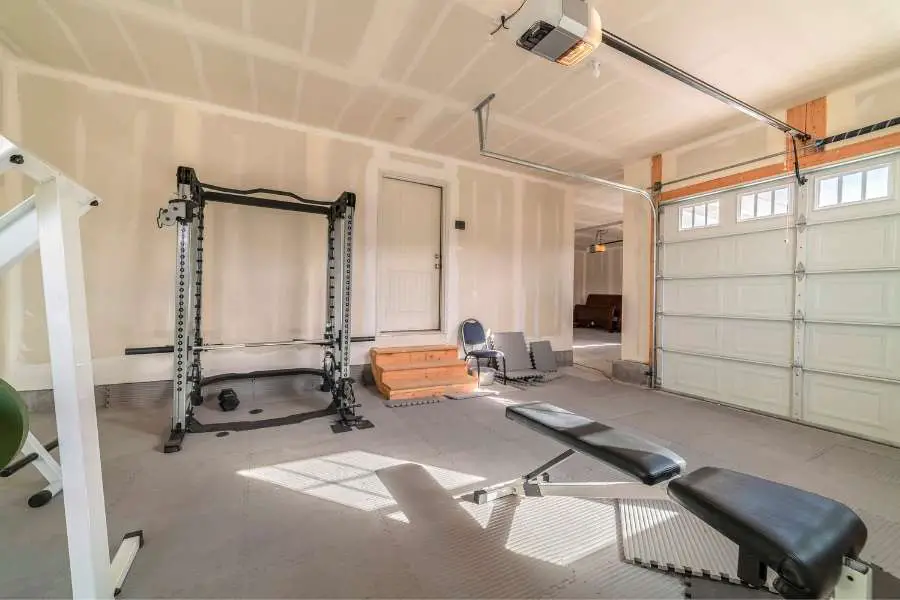
Example #2: Free weights setup with dumbbells
If you don’t have enough space for the first setup; this is a good alternative;
- Bench
- Dumbbells
It’s very simple and basic. With those two things you can do a ton of exercises though.
The downside is that you can’t lift as heavy as with the barbell and rack. And if you run out of dumbbells and want to go heavier, you need to buy a whole new pair of them. This gets quite expensive.
So this is only recommended for people who want to lift a limited amount of weight. Most standard sets of dumbbells go up to 50 or 60 lbs. You can of course get heavier ones but they are expensive and also start taking up so much space that it might not be worth it compared to the first setup.
If we assume a standard set of dumbbells (5-50 lbs.), how much space do you need for this setup?
Width
Because there is no barbell this time, the minimum width you need is a bit narrower. It’s not as much less as you might think though.
The widest dumbbell exercise you’ll likely do is the dumbbell fly. That means you stretch both your arms to the side with a dumbbell in your hand. Your ‘wingspan’ is approximately equal to your height. The dumbbells will add a few inches on both sides because they stick out a little. That means you need at least your height + 10” in width. That means 7’ wide is enough for most people to work out with dumbbells.
Length
The length requirement doesn’t change from the first setup. You still have the bench to lay down on. That means 8’ of length.
Total
For this setup with dumbbells and bench you need a room that measures at least 7’ by 8’.
Can you go smaller? Yes but you’ll start limiting the exercises you can do. The absolute minimum would be 6’ x 5’. However, then you have to use adjustable dumbbells to save space.
You will also push your bench against the wall on one side and likely hit your knees on the other wall. Possible, yes. But not comfortable or very practical. In a 7’ by 8’ space you can do almost every exercise in comfort. It also allows enough room for a rack with a full set of dumbbells.
Example #3: Dumbbells, barbell and rack
Now if you’ve got the money and space, I would recommend going for a combination of the two examples above;
- Bench
- Barbell
- Weight plates
- Rack/stand
- Dumbbells
If you want to see which equipment I recommend for home gyms, click here.
So here you simply add on the dumbbells to the equipment of the first example. They don’t take up much extra space. You could even opt for a set of adjustable dumbbells which take up even less space than a full rack of fixed ones. Adjustable dumbbells are just the size of a single pair of large dumbbells. You basically get 15 pairs of dumbbells in the space of 1 large pair.
This will provide the best of both worlds. Dumbbells and barbells both have their uses and having them both means more exercise flexibility.
Size
The only thing you’re really adding compared to setup #1 is a dumbbell rack. We already have enough space to use it as intended.
A dumbbell rack for home use measures about 2’ by 3’. You can get ones that are more vertical and thus have a smaller footprint but those tend to only hold lighter dumbbells.
If you only go for light dumbbells (Up to +-30 lbs.), you can use a vertical rack and put it in a corner where it won’t be in the way. In that case, the space requirement is the same as for setup #1. If you choose a bigger dumbbell rack, it’s good to add one foot to either the length or width of your home weight room.
It’s not necessary to add the full two feet of depth the rack is deep to your room. Because you can put the rack in a corner that would otherwise be sparsely used anyways.
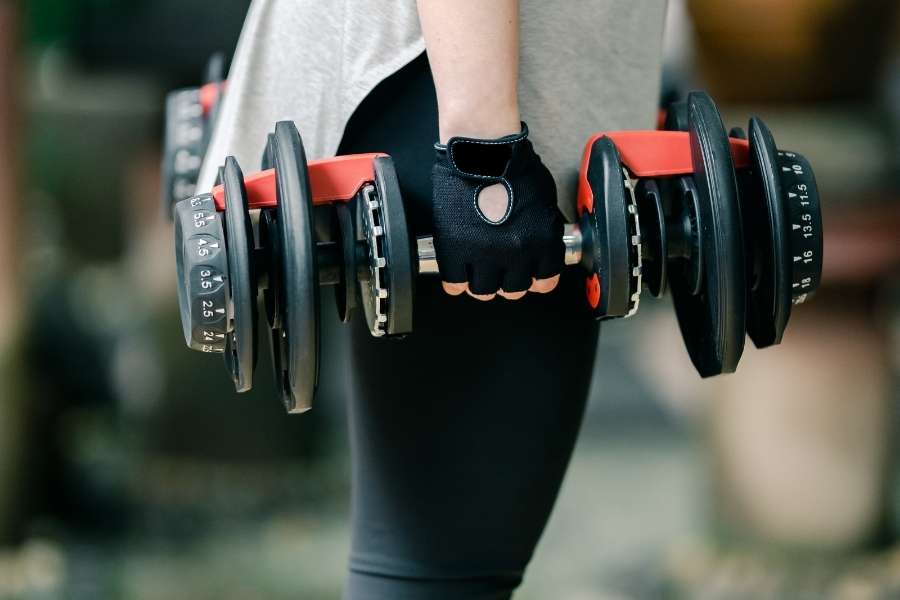
Example #4: All in one multi-gym
Ok, here is a bonus option for weightlifters: A multi station home gym. This is a machine that combines a lot of different exercises into just one piece of equipment. This isn’t a free weights setup which might actually be a pro for some people.
Some people don’t like the free weights or feel intimidated by them. While free weights are more effective in building muscle, the ease of use of machines is hard to deny.
Luckily you can fit an all-in-one home gym in roughly the same space as a free weights setup so you’ve got the choice.
There are many different machines that do this all with different foot prints and size requirements.
Click here to find a post that goes into depth how much space you need for a multi-gym.
A large multi-gym will require a floor space about 6′ by 9′ during use while a small model only needs 6′ by 5′.
https://homegymresource.com/how-much-floor-space-is-needed-for-a-multi-gym/
How Much Space Does a Home Cardio Machine Need?
Just like with weightlifting equipment, there is a lot of difference in cardio machines and how much space they take up. Luckily most cardio machines don’t need all that much space around it to be used properly. That makes it easier to place them and figure out how much space you need.
There are many different types of cardio machine and within every type there are countless models with different sizes. Since it’s not very practical to post the dimensions of every model here, I’ve opted to show you the averages.
Average cardio machine foot print
Here are the average foot prints of the specific type of cardio machine for home use. Commercial machines tend to be bigger. These are just indications; check the dimensions of your machine.
- Treadmill: 75” by 35”
- Elliptical: 68.1” by 28.5”
- Rowing machine: 96” by 24”
- Exercise bike: 57.6” x W: 24.9
The treadmill and elliptical trainer don’t need any extra space around it to be use. The rowing machine and needs at least 4’ of width when used while an exercise bike needs about 3′. That’s only in use. When not using it, you only need the dimensions quoted above.
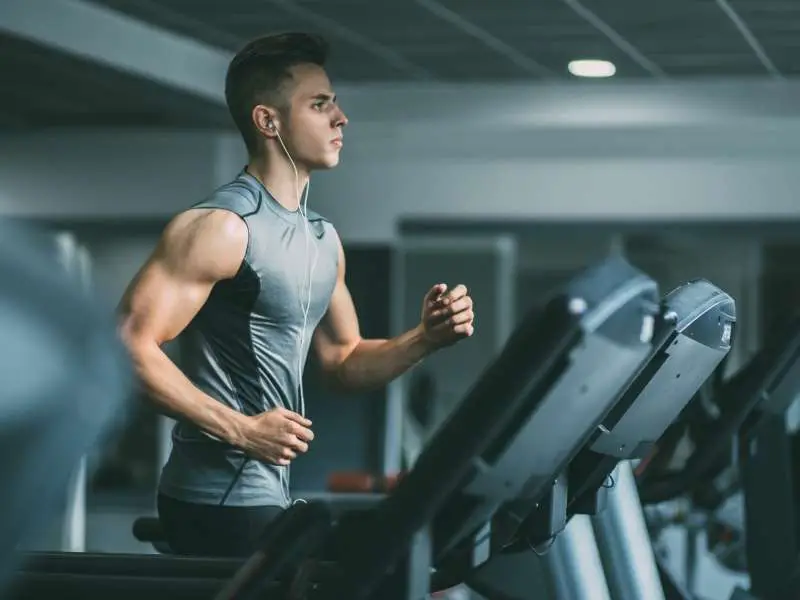
How Much Space Do You Need To Do Bodyweight Exercises?
If you only want to do bodyweight exercises and don’t need any other equipment, I wouldn’t really bother setting up a home gym. Just a large enough yoga mat and some free space will do the trick. No need to reserve a whole room for this. Even if you want to use resistance bands, you can do your exercises in any open space.
However, if you want to do bodyweight exercises as well as use equipment, it’s useful to keep in mind how much free space you need.
Many bodyweight exercises require very little space. Many are performed standing up like;
- Bodyweight squats
- Lunges
- Pistol squats
- Step ups
- Box jumps
These exercises need very little room. A free space of 4’ by 5’ is enough to perform these comfortably.
For other bodyweight exercises you want to be horizontal;
- Push ups
- Burpees
- Crunches
- Glute bridge
For these exercises you’ll need at least your height in length available because you are lying on the floor. Preferably 1 or 2 feet more than your height because if it’s exactly the same you’ll bump your head into the wall. Also, you move around during exercise and you don’t want to be worried about hitting your head the whole time. So if you’re 6’ tall, an 8’ long free space is appropriate.
A space 4’ wide is enough to perform most bodyweight exercises but a little wider would be comfortable.
If you want to bodyweight exercises next to a cardio machine, you have to add on this amount of space. However, if you have a free weights setup, you can of course use the same space as for those exercises. Is there space to do a barbell squat? Then you have enough space to do bodyweight squats and most standing exercises. If you can fit a bench in the rack and lay down on it, you almost have enough space to do lying bodyweight exercises. Just add 2’ or 3’ to the length of the room and you can do everything.
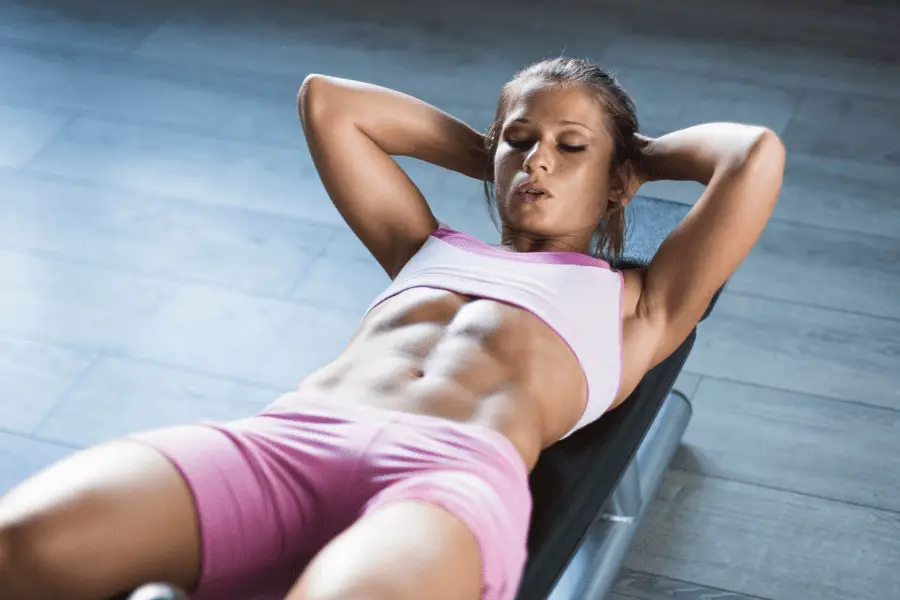
Combinations
The space requirements above are split up into weightlifting, cardio and bodyweight exercises. However, there is a good chance you want to have the option to do a combination of those things in your home gym.
The weightlifting and cardio machines are easy to figure out. Just add the space requirements of the two. Take the minimum space requirement for both and add them up.
If you have a weightlifting setup, you’ll have enough space to do bodyweight exercises when you get the bench out of the way. If you want to have a cardio machine and space to do bodyweight exercises, you have to add up both.
Here are some examples of what that means;
| Setup | Width (inch) | Length (inch) | Total (sq. ft.) |
|---|---|---|---|
| W#1: Power rack +Barbell + Bench | 89 | 96 | 59.3 |
| W#2: Dumbbells + Bench | 84 | 96 | 55.9 |
| W#3: DB +BB+ Rack + Bench | 101 | 96 | 67.3 |
| Multi station gym (small) | 72 | 60 | 29.9 |
| Multi station gym (large) | 72 | 108 | 53.9 |
| Treadmill | 35 | 75 | 18.2 |
| Elliptical | 28.5 | 68.1 | 13.5 |
| Rowing machine | 48 | 96 | 31.9 |
| Exercise bike | 36 | 57.6 | 14.4 |
| Bodyweight exercises | 48 | 96 | 31.9 |
| W#1 + Treadmill | 124 | 96 | 82.6 |
| W#2 + Treadmill | 119 | 96 | 79.3 |
| W#3 +Treadmill | 136 | 96 | 90.6 |
| W#2 + Rowing machine | 132 | 96 | 87.9 |
| W#3 + Elliptical | 129.5 | 96 | 86.3 |
Home Gym Space Savers
Looking at all of this made you realize that you don’t have enough space to do everything you want? Here are some possible solutions:
Folding power rack
The power rack is the item that takes up the most floor space. It’s also the most versatile. That means you don’t want to get rid of it since it would limit your exercise options a lot. But what if it’s the only thing you can fit in your home gym?
A foldable power rack is your solution here. A foldable rack can be reduced to just some metal piping on the wall that barely takes up any space. Once you’re done with whatever you use the power rack for, fold it away and you’ve got a lot of room for other things. It’s the perfect solution for those in a small home gym.
If you’re using a foldable power rack, it’s important that you have space to put all your barbells and weights that you would store on the rack otherwise. Of course you can stack the weights in a corner so it doesn’t take up a lot of space but it’s something to keep in mind.
Adjustable dumbbells
Another option to save money is to get adjustable dumbbells. You can adjust the weights on the dumbbells easily. That means you can go from low weights to high weights with just two dumbbells. The whole set with all the weights is just a little bigger than two heavy dumbbells. This saves you the space of at least 10 pairs of dumbbells. The only limitation is that the adjustable ones might not go up heavy enough for some people.
But with this BowFlex adjustable dumbbell set (Amazon link), you can go from 5 lbs. to 52.5. Lbs. That should be enough for most people. They’re not as expensive as you might think. Only a little bit more expensive than buying all the separate dumbbells. It’s actually a dumbbell set I recommend the majority of home gym owners get.
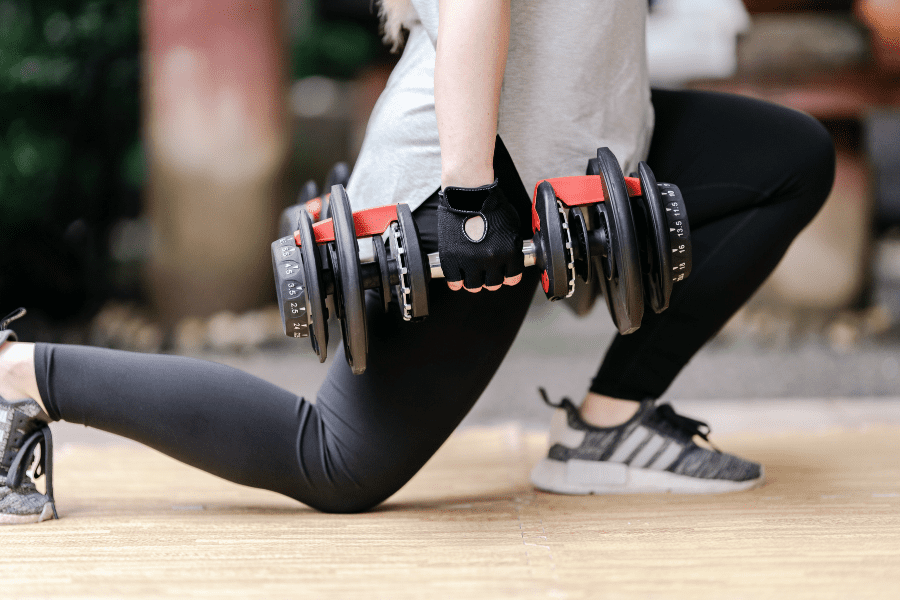
Folding bench
Next up is a folding bench (Amazon link). A folding bench is a great space saver and it saves that space where it counts; in the middle of your gym. When you want to do exercises that don’t require a bench, that thing is just in the way.
Usually in a home gym you can choose to push it aside or outside the room if there’s not enough space. With a folding bench you can fold up the legs and lean it against a wall and it’s out of the way.
The drawback of a folding bench is that the load limit is usually lower so you can’t lift as heavy as some other benches. On the other hand, not that many people bench press over 300 lbs. so for the majority of home gym owners a folding bench is fine.
Folding treadmill/rower
Some treadmills have the option to fold the deck (part you actually run on) up. This frees up quite a bit of floor space when not using the treadmill.
Most popular rowers can do something similar. The longest part of a rower is the slide rail. This rail is easily folded up though. That means your rowing machine suddenly takes up a whole lot less space.
The benefit of folding machines is obvious; more floor space when not using them. Fold them down when you want to use the machine and you don’t use the free floor space anyways.
The downside, especially with treadmills, is that it ads complexity. More things that can break. If you pay the same amount of money for a fixed treadmill, that money can go into improving another part.
